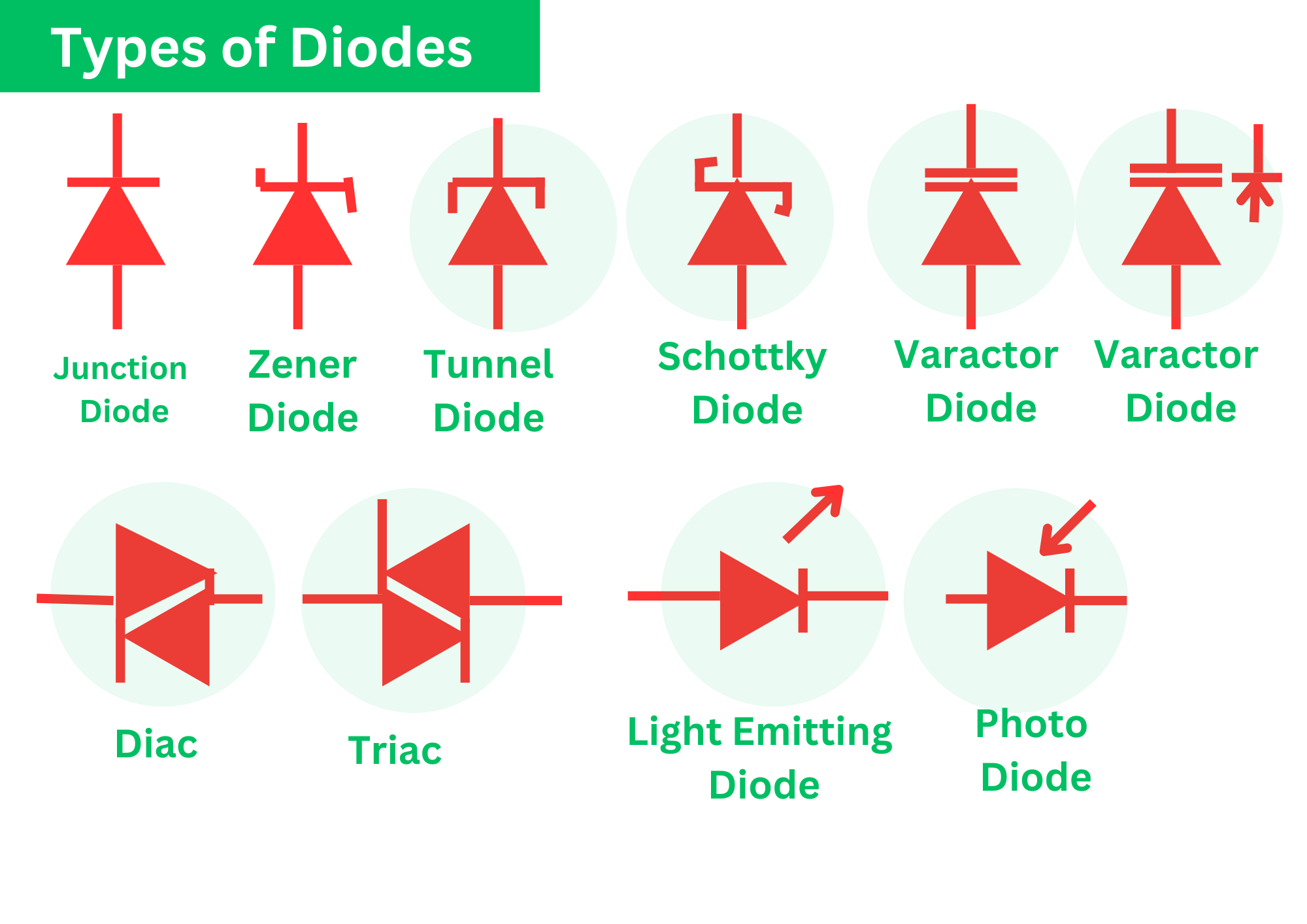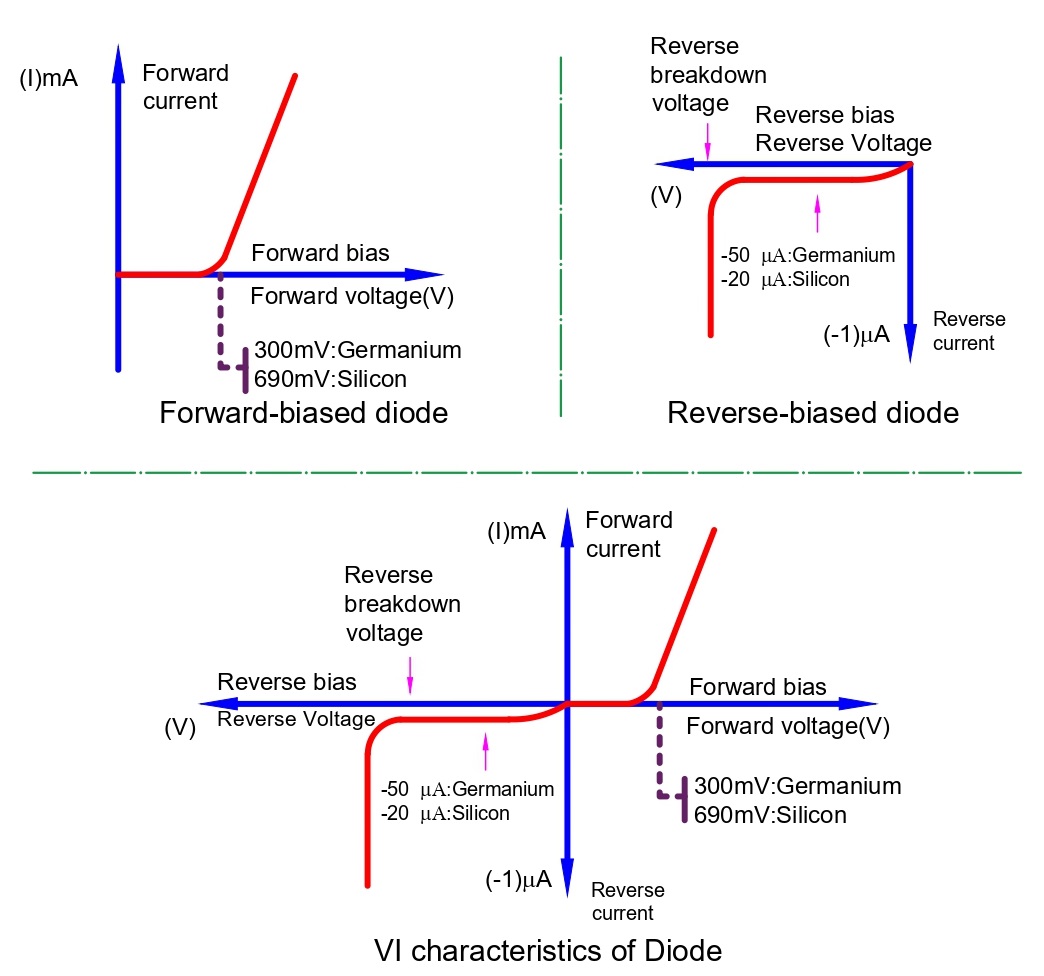A diode is an electronic component with two terminals that allows electricity to flow in only one direction. One end of the diode has high resistance, while the other end has low resistance. In this article, we will delve into what a diode is and its symbol.
What is a Diode?
Diodes indeed serve as crucial components in modern electronic devices, primarily due to their ability to regulate voltage and ensure that current flows in a single direction. This unidirectional conductance is what permits diodes to convert Alternating Current (AC) into Direct Current (DC), a fundamental process in power supplies that enables the consistent operation of DC electronics.
The heart of a diode’s functionality lies within its semiconductor material. Common materials like silicon and germanium are specifically chosen for their ability to control electrical conductivity. Semiconductors can act as insulators at some temperatures and conductors at others. This flexibility is key to the operation of diodes, as it allows them to pass current more effectively in one direction while resisting flow in the opposite direction, thereby serving as a one-way gate for electrical current.
Diodes come in a variety of shapes and functions to suit different purposes:
Diode Symbol

The above diagram shows the standard symbol for a diode, which consists of two terminals known as the anode and cathode. The anode is represented by an arrowhead that indicates the direction of the conventional current flow when the diode is forward-biased. The opposite end is the cathode.
Diode Construction
Diodes are electronic components that can be made of two types of semiconductor materials: silicon and germanium. When the anode voltage is more positive than the cathode voltage, the diode is forward-biased and conducts easily with a low-voltage drop. On the other hand, when the cathode voltage is more positive than the anode voltage, the diode is reverse-biased, and it doesn’t conduct. The arrow in the diode symbol represents the direction of current flow when the diode conducts.
Types of Diodes
- Light Emitting Diode
- Laser diode
- Avalanche diode
- Zener diode
- Schottky diode
- Photodiode
- PN junction diode

Light Emitting Diode (LED)
When an electric current flows between the electrodes of a diode, it produces light. In other words, light is generated only when a sufficient amount of forward current passes through it. Although there are frequency levels that do not allow visibility, many diodes can produce light that is not visible to the naked eye. LEDs come in various colors, and some can even emit three colors at once. The color of light depends on the energy gap of the semiconductor used.
Laser Diode
This describes a particular type of diode that produces coherent light, which is commonly used in CD drives, DVDs, and laser devices. While these diodes are more expensive than LEDs, they are more affordable than other laser generators. The only drawback is that they have a limited lifespan.
Avalanche Diode
This particular diode operates in reverse bias and uses the avalanche effect. When the voltage drop remains constant and is not affected by current, the avalanche breakdown occurs. Because of their high sensitivity, these diodes are often used for photodetection.
Zener Diode
Zener diodes are a type of diode that are highly useful as they can provide a stable reference voltage. These diodes are operated in reverse bias and break down when a certain voltage is applied. When the amount of electrical current flowing through a resistor is restricted, it produces a consistent voltage output. Therefore, Zener diodes are widely used in power supplies to provide a reference voltage.
Schottky Diode
Schottky diodes possess a lower forward voltage as compared to other silicon PN junction diodes. This voltage drop can be observed when there is a low current, and the voltage range falls between 0.15 and 0.4 volts. Schottky diodes are constructed differently from other diodes to achieve this performance. As a result, they are commonly used in rectifier applications.
Photodiode
A photodiode is a specialized type of diode that can detect even small amounts of current flow resulting from light. This makes it an extremely useful tool for light detection. Photodiodes are typically reverse-biased and are commonly used in solar cells and photometers. They can also generate electricity.
P-N Junction Diode
The P-N junction diode, also known as a rectifier diode, is an electronic component that is predominantly used in the rectification process. It is composed of semiconductor material, with two layers of semiconductors, one doped with P-type material and the other with N-type material. The junction formed between these layers is called the P-N junction, giving the diode its name.
The P-N junction diode conducts current in the forward direction and blocks it in the reverse direction.
Characteristics of Diode
The characteristics of a diode can be better understood by considering its operation in three distinct regions.
- Forward-biased diode
- Reverse-biased diode
- Zero biased diode

Forward-biased Diode
When a diode is forward-biased and conducting current, a small voltage drop occurs across it. For silicon diodes, this voltage drop is 690mV, and for germanium diodes, it is 300mV. The p-type material has a positive potential energy, while the n-type material has a negative potential energy.
Reverse-biased Diode
When the voltage of a battery isapplied in the opposite direction, a diode is considered to be reverse-biased. In the case of silicon diodes, the reverse current is -20μA, whereas for germanium, it is -50μA. The potential energy is negative across the p-type material and positive across the n-type material. If the reverse voltage is increased beyond a certain point, the diode begins to conduct in reverse, shown by a sharp downward turn in the graph.
Zero-biased Diode
When a diode is zero-biased, no external voltage is applied to it, and the voltage potential across the diode is zero.
Diode Applications
Following are the applications and uses of the diode:
- Power Conversion (Rectifiers)
- Diodes in the clipping circuit
- Diodes in clamping circuits
- Diodes in logical gates
- Diodes in reverse current protection
- Signal Demodulation and Modulation
- Overvoltage Protection
- Light Emission and Sensing
- Data Storage and Output
- Medical Applications
- High-Frequency Applications
Conclusion:
Diodes are a fundamental component in the realm of electronics, characterized by their unique ability to conduct current in one direction while blocking it in the opposite direction. This is visually represented by their symbol, which consists of a triangle pointing towards a line, epitomizing the one-way flow of current. Diodes function based on the principle of allowing electron flow from the negatively charged cathode to the positively charged anode, and not in the reverse direction.
In terms of structure, diodes are made from semiconductor materials such as silicon, germanium, or selenium. These materials are doped to create a PN junction, which is the core of diode functionality. The variety of diodes includes standard rectifier diodes, Zener diodes for voltage regulation, LEDs for light emission, Schottky diodes for fast switching, and many more, each tailored for specific applications.
The V-I (voltage-current) characteristics of diodes are pivotal for understanding their operation. These characteristics display the diode’s behavior under different voltage applications, showcasing a sharp increase in current conduction once the forward voltage exceeds a threshold, while exhibiting high resistance in the reverse direction until the breakdown voltage is reached.
Diodes are utilized across a broad spectrum of applications due to these properties. They serve critical roles in power conversion, signal modulation and demodulation, overvoltage protection, and light emission and sensing. Moreover, diodes are essential in data storage, communication technology, and even medical equipment, underscoring their versatility and indispensability in modern electronic and technological applications.
Understanding the various types, operational characteristics, and widespread uses of diodes illuminates their integral role in both everyday and advanced technological systems. This knowledge not only enriches our comprehension of electronic components but also highlights the ongoing potential for innovation in semiconductor technology.